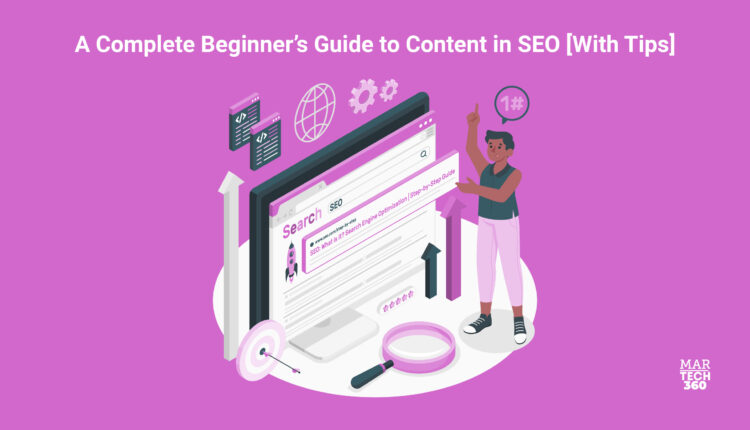Writing content for Google to prick it apart so the content could rank first could be daunting but not completely impossible. The best kind of content is the one that answers the readers with actionable results to their search intent.
This is where creating content in SEO (search engine optimization) comes into the picture. You could write the best quality content, and it would be useless if you don’t know how to bring it to your audience. Fret not, this blog covers the most important areas of SEO content that can help you rank first.
What is Content in SEO?
 Content in SEO generally means making content for your website that promotes high search engine rankings. It covers every aspect, including creating and organizing the website’s content.
Content in SEO generally means making content for your website that promotes high search engine rankings. It covers every aspect, including creating and organizing the website’s content.
Your website’s ranking is influenced by three essential factors: keyword strategy, site structure, and copywriting.
You must be thinking what is copywriting doing in content, right?
SEO copywriting can be compared to a sales engine that satisfies Google and site visitors. When you know how to tell search engines what your content is about and also give website visitors the most detailed and engaging experience, both sides win.
Why is content SEO crucial in the first place? The words you use affect your website’s ranks in search engine results pages because search engines like Google read your content.
Of course, your website needs to be well-designed, have a fantastic user experience, and have all the technical aspects taken care of for it to rank well on Google.
However, your website has no chance of ranking well in search engines if it lacks excellent content.
● Keyword Research
Keyword research is the process you use to compile a long list of phrases for which you want readers to find your website. Every content SEO plan should start with keyword research since, to drive traffic, you need to understand what your audience is looking for.
There are four steps to keyword research:
- Jot down your company’s mission
- List all of the search terms you want to be discovered for
- Research the search intent of your target audience
- Develop landing pages for these keywords
Why do you need keyword research? Consider this – you are selling mobile phones and miss out on using the keyword “mobile phones” on your website. Result? Zero sales.
This is where keyword research helps, it makes sure you are using the right words as your audience.
Make sure to include major keywords within the first 100 words.
Here are some major pointers you need to remember:
- Keywords and key phrases: A keyword can be a single word or a phrase of multiple words.
- Long-tail keywords: Long-tail keywords are more specialized and narrowly focused. Compared to short-tail keywords, they are simpler to rank for.
- How many keywords?: There is no exact number of keywords you should focus on, but you should have as many as you can come up with.
- Head or tail?: Head keywords are extremely popular and highly competitive, whereas tail keywords are more niche and less so. It’s crucial to incorporate both within your material.
Below are some types of search intent to help you enhance your website’s visibility:
- Navigational intent: People want to go to a specific website. For example, if you want to go to Google, you might search for “Google.”
- Informational intent: People want to learn about something. For example, if you want to learn how to cook a certain dish, you might search for “how to make brownies”.
- Commercial intent: People are considering buying something. For example, if you’re looking to buy a new car, you might search for “best cars under $15,000”.
- Transactional intent: People are ready to buy something. For example, if you’re ready to buy a new car, you might search for “buy a car”.
There are tons of keyword research tools you can use. Google Keyword Planner, Moz Keyword Explorer, Ubersuggest, and Ahrefs are some of the best free tools out there.
● Site Structure
Site structure is an important ranking factor for SEO content. A good site structure will help Google understand your site and where to find the most important content.
It will also help you avoid competing with your content for ranking.
An ideal site structure is like a pyramid, with your homepage at the top and more specific pages linked to it.
You should focus your efforts on cornerstone content, which are the articles that you’re proudest of and that fits the mission of your website best. You should also link from your “tail” articles to your cornerstone articles.
You can improve your site structure by using tags, avoiding duplicate content, removing old content, and dealing with orphaned content and content cannibalization.
Here are some specific tips for improving your site structure:
- Decide upon cornerstone content and make sure they are the best articles on your site
- Link from your “tail” articles to your cornerstone articles
- Use tags to group your articles about similar topics
- Avoid duplicate content by canonicalizing your URLs
- Remove old content if it is outdated or no longer relevant
- Deal with orphaned content (articles without any links to your previous posts or articles) by linking to them from other articles
- Deal with content cannibalization by merging or redirecting duplicate content
By following these tips, you can improve your site structure and boost your SEO content rankings.
● Copywriting
The three winning formulae for content in SEO are content, content, and content.
According to HubSpot, companies that consistently publish blog posts receive 350% more traffic than those that don’t. Some key pointers:
Readability is vital for both your audience and Google: If your text is structured and written well, readers will be able to clearly comprehend your content. And so will Google! If Google understands your content, it is far more likely to rank well.
Content and search intent: Google is getting smarter and can understand the content on sites better. It takes into account the context of keywords, like co-occurring terms and phrases, related words, and synonyms. It also tries to determine the search intent of the user.
Optimize content for search engines and readers: In addition to writing readable content, you also need content optimization in SEO. This means using relevant keywords throughout your content and making sure your content is easy to find.
Here are some specific tips for writing readable and SEO-friendly content:
- Use clear and concise language: Avoid complex and technical terms that your audience may not understand.
- Break up your text into short paragraphs and sentences: This will make it easier for readers to skim and scan your content.
- Use headings and subheadings to organize your content: This will help readers quickly find the information they’re looking for.
- Use keywords throughout your content, but don’t overdo it: You want your content to be readable and informative, not just keyword soup.
- Link to related content on your site: This will help Google understand the context of your content and how it relates to other content on your site.
- Promote your content on social media and other channels: This will help you get more eyes on your content and increase your chances of ranking well on search engines.
By following these tips, you can write readable and SEO-friendly content that will help your website attract more visitors.
● Top 10 SEO Ranking Factors

The importance of content backed by best SEO practices is paramount. Let’s have a quick look at the top 10 SEO ranking factors that decide the position of your content.
- Secure and Accessible Website
- Page Speed (Including Mobile Page Speed)
- Mobile Friendliness
- Domain Age, URL, and Authority
- Optimized Content
- Technical SEO
- User Experience
- Links (Backlinks, Outbound, and Internal)
- Social Signals
- Real Business Information
Final Words
Quality content is insufficient. Your article must be one of the top results for a certain search in order to rank well. Amazing content plus solid SEO practices is the secret to SEO success.
According to Backlinko’s analysis of Google ranking signals, the top 10 results for the majority of keywords tend to be 1,447 words long on average.
Your content won’t rank if it’s difficult to read and comprehend regardless of how perfect your on-page SEO is.
That’s because Google now determines which results deserve to rank #1 in the SERPs by using “User Experience Signals” in addition to conventional ranking signals like backlinks.
It’s important to remember that SEO can take some time.
Even if you abide by these instructions completely, it can still take 2-3 months for SEO to “kick in”. Therefore, don’t anticipate a brand-new piece of original content in SEO to rank in Google the next day.


Comments are closed.